
Hey there, bird lovers!
Do you ever find yourself gazing up at the sky, wondering about the amazing adaptations that have allowed our feathered friends to thrive? If so, then you’re in for a treat! Today, we’re going to take a closer look at birds with pointed bills.
Many bird species have pointed bills.
- Warblers have thin, pointed bill used in searching for insects.
- Woodpecker bills are used for excavating.
- The heavy, pointed bills of the herons and egrets are used for stabbing their prey.
There are so many species with pointed bills, you may find that this characteristic is most useful in determining what the bird is NOT.
In fact, a common approach to identifying a particular bird is to start by determining what it could not be.
So, whether you’re a seasoned birder or just starting out, get ready to learn something new about these incredible creatures. Grab your binoculars, and let’s take a closer look at the amazing world of birds with pointed bills!
On this page
Herons, Egrets, and Bitterns – Family Ardeidae
Birds belonging to the Ardeidae family are medium-to-large-sized wading birds characterized by long necks and legs. On average, their bills are long and pointed, perfect for stabbing prey. They also use it to attack intruders and even each other.
Reddish Egret
Egretta rufescens
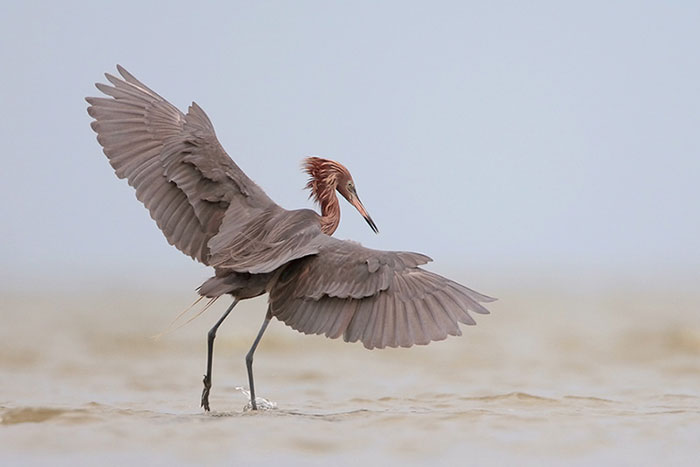
The Reddish Egret is a near-threatened species that can be found along coastal areas, especially mud flats, stretching from the southernmost United States to the northernmost parts of South America. Their dark morph has a gray body and rust-colored neck and head, whereas their white morph is pure white all over.
These egrets are active foragers, often stalking, running, leaping, and spreading their wings. You can also recognize them by their pointed bills. Non-breeding adults and immatures have dark bills. White morphs and breeding dark morphs have pink bills with black tips.
Great Egret
Ardea alba
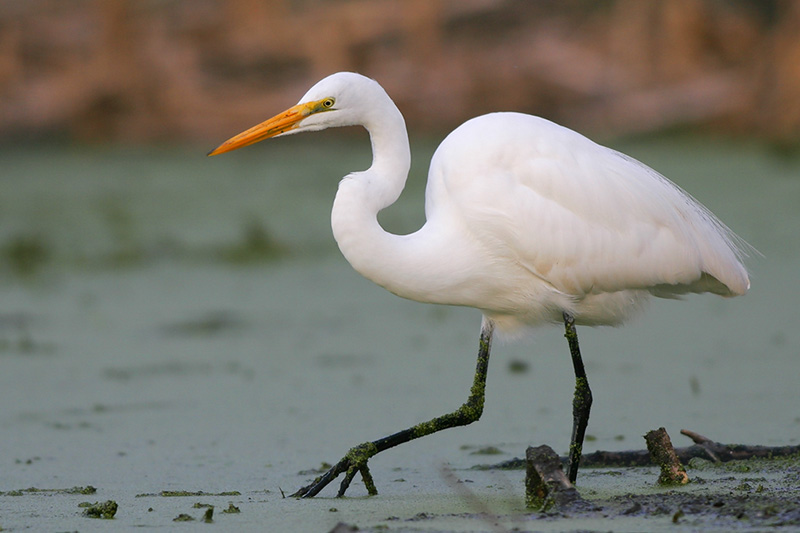
Photograph © Greg Lavaty.
The Great Egret can be found in North America mainly during the breeding season, although some of its population along the east coast and Florida are year-round residents. They always live near water, showing a preference for wooded swamps and wetlands. These beauties are all white and become even more dazzling during the breeding season when they sprout long feathery aigrettes on their back.
One defining feature of the Great Egret is its long, dagger-like yellow bill, which plays a crucial role in its survival.
When foraging for food, these elegant creatures often stand or wade in shallow water, swiftly spearing their next meal with a sudden and precise thrust of their elongated neck and bill.
It is also worth noting that nestlings can be highly competitive, and in some cases, their rivalry can escalate to the point where they stab their nest-mates to death.
Little Blue Heron
Egretta caerulea
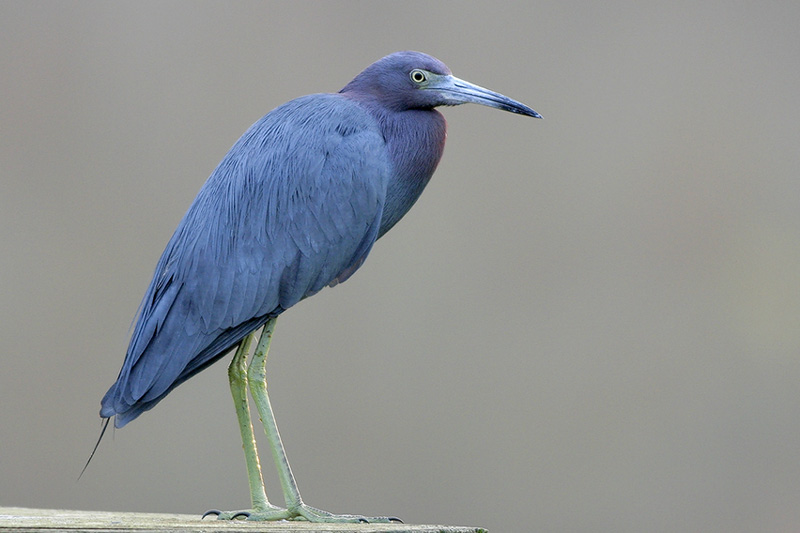
Little Blue Heron
In North America, the Little Blue Herons are primarily found throughout the southeastern United States, with a year-round population along the coastline and in Florida. This smaller heron species is most abundant in freshwater environments, river swamps, and marshy lakes.
Adult Little Blue Herons are uniformly dark in color. Upon closer inspection or in good lighting, their heads and necks reveal a rich purple-maroon hue, while their bodies appear slate-blue. They have yellow eyes, greenish legs, and a bill that transitions from pale blue at the base to black at the tip.
As with most others, they primarily use their bill for hunting. They approach this task more patiently and often stand still and await their prey.
If necessary, these herons may chase and attack other members of their species, striking and jabbing at each other with their bills to defend their food or nesting territory. Even nest-mates can be aggressive and stab each other to death.
Cranes – Family Gruidae
Cranes are similar to herons but hold their necks outstretched while flying. Their bills are also similar – long, slender, and pointed. They use their bills to probe the ground for prey and some species also use them to stab intruders.
Sandhill Crane
Antigone canadensis
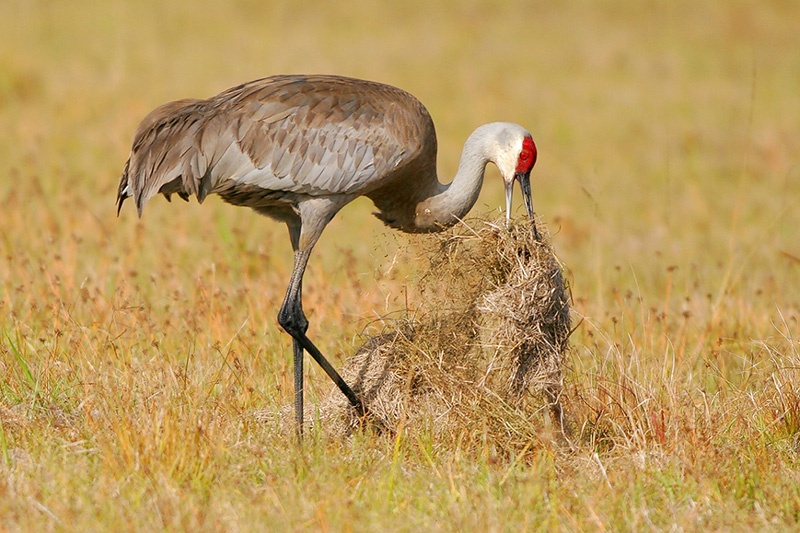
Some show a brown-stained appearance. Photograph © Greg Lavaty.
Sandhill Cranes range across most of North America, nesting in open grasslands, wet meadows, and marshes. Although they prefer to avoid human settlements, then during migration, they may feed on crops in agricultural fields.
With their large size, long necks, legs, and broad wings, Sandhill Cranes are striking birds. They have slate gray plumage with a rusty hue on their upperparts, pale cheeks, red crown skin, and black legs.
When faced with a terrestrial predator, Sandhill Cranes approach it with wings spread and bills directed toward the threat.
If the predator doesn’t take the hint, they become more aggressive, hissing, stabbing with their bills, and kicking with their feet.
Their sharp bills are capable of piercing the predator’s skull, and they’re even known for having killed coyotes.
Gulls, Terns, and Skimmers – Family Laridae
Laridae is a large family of seabirds. Generally speaking, gulls have heavy and slightly hooked bills that they use to feed on anything they can get their bills on, from fish and invertebrates to eggs, seeds, reptiles, and carrion.
Terns have long and straight bills and skimmers have distinctively long bills, with their lower mandible being longer than the upper one.
Black Tern
Chlidonias niger
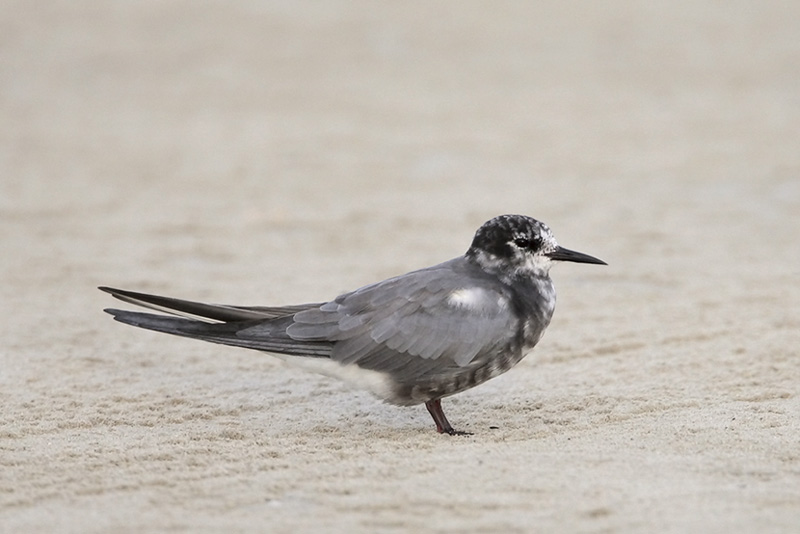
The Black Tern inhabits freshwater marshes from most of Canada to the northern United States during the breeding season and migrates to the northern coast of South America for the winter. These seabirds are small and delicately built, characterized by a slender, pointed bill, long and pointed wings, a shallowly forked tail, and short legs.
During the breeding season, adults are dark gray above, have black heads and underparts, and pale underwings and undertail coverts. In their non-breeding plumage, adults appear gray above and whitish below, and have a dusky crown, ear-patch, and mark on the side of the breast.
Their short black bills, slightly longer than their heads, are slender and slightly decurved. Black Terns use their bills for foraging and defending against intruders.
Royal Tern
Thalasseus maximus

The Royal Tern is a crow-sized seabird found along both coasts and beaches of the Americas. It has a slender and long-winged body and a relatively large head with a crest. Their long tails are forked and their elongated bills resemble daggers.
Royal Terns have gray uppersides, white undersides, a shaggy crest, and an orange bill. During the breeding season, they have a black cap whereas in their non-breeding plumage, their forehead is white.
They mostly forage by hovering over water and diving just below the surface to catch their prey. Occasionally, you may see them flying low over the surface, skimming the water with their bills, or catching fish mid-air.
Sandwich Tern
Thalasseus sandvicensis
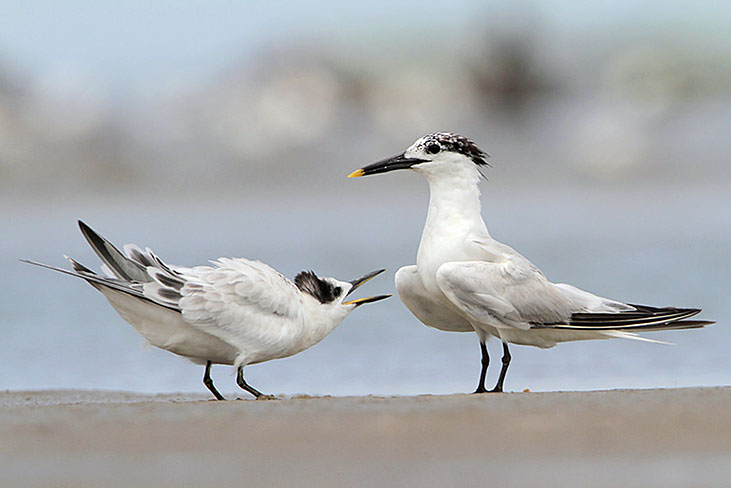
The Sandwich Tern is primarily a coastal species. In the Americas, they inhabit various coastal environments such as beaches, cliffs, and estuaries. They range from as far north as Virginia in the United States to the northernmost regions of Chile along the western coast of South America, and down to the southern parts of Argentina along the eastern coast.
This crow-sized tern has a slender body, a long and thin bill with a sharp tip, and long, pointed wings. During the breeding season, adult Sandwich Terns sport a shaggy crest that gives a rugged appearance to the back of their heads. They have pale gray plumage above, white plumage below, a black crest, and a black bill with a yellow tip. Non-breeding adults have a white forehead with little or no crest.
When foraging, Sandwich Terns plunge headfirst into the water from flight, often hovering briefly beforehand. They swiftly emerge with fish clasped in their bills. Additionally, they may capture insects while in flight.
Woodpeckers – Family Picidae
Woodpeckers have strong and generally long bills that they use for drilling, excavating, and foraging. The bill’s tip is often like a chisel.
Hairy Woodpecker
Leuconotopicus villosus
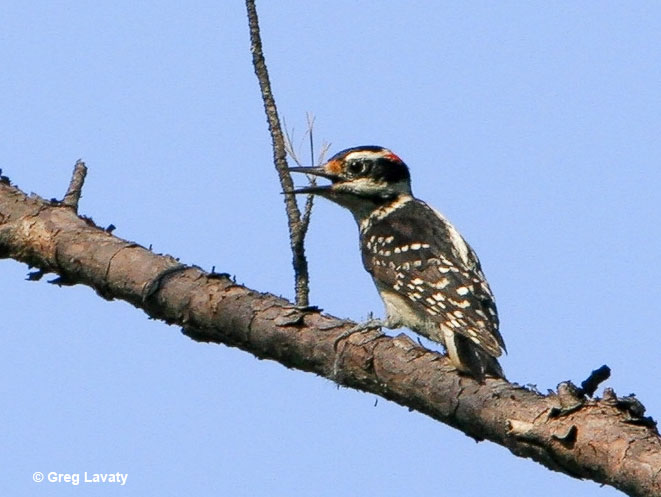
Hairy Woodpecker
The Hairy Woodpecker is a widespread species found throughout most of North America and parts of Central America. They can adapt to various habitats, thriving in areas where there are large trees, such as forests, woodlands, river groves, and swamps.
The plumage of the Hairy Woodpecker is characterized by a striking black-and-white pattern. Their black wings are adorned with white checkering, while the underside is predominantly white. They have two white stripes on its head, and in males, there is a flash of red towards the back of the head. A notable white patch runs down the center of its otherwise black back.
Their long and black chisel-like bill is almost as long as their head! They mainly use it for foraging, probing, excavating, and ripping off bark to uncover insects.
Pileated Woodpecker
Dryocopus pileatus
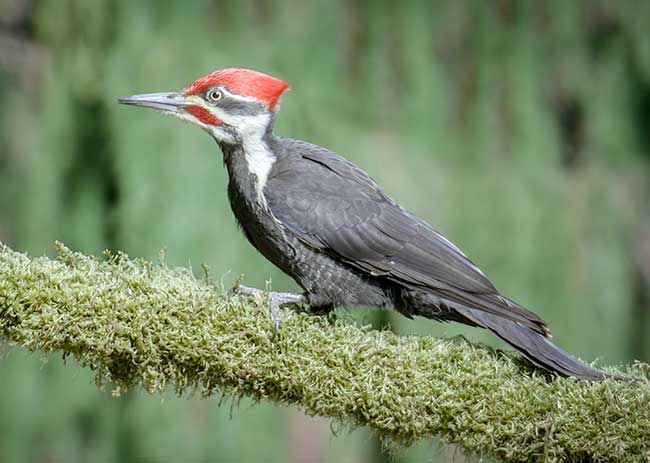
Pileated Woodpeckers are year-round residents in mature forests in southern Canada and in the eastern, midwestern, and western United States.
This impressive woodpecker, the largest in North America, has a long neck and a distinctive triangular crest. Its predominantly black plumage is adorned with white stripes on the face and neck and extensive white underwings. Both sexes have a vibrant flame-red crest, and males have an additional red stripe on their cheeks.
Their long and chisel-like bills are an important part of their everyday activities, from foraging to claiming territory and excavating nest cavities.
They pry, probe, and excavate in dead wood to uncover insects, occasionally even gouging deep holes in rotten wood and tearing apart stumps and fallen logs.
Wrens – Family Troglodytidae
Wrens typically have a very thin bill which is sometimes slightly decurved, making it easier for them to search for insects in the smallest crevices and holes.
Bewick’s Wren
Thryomanes bewickii
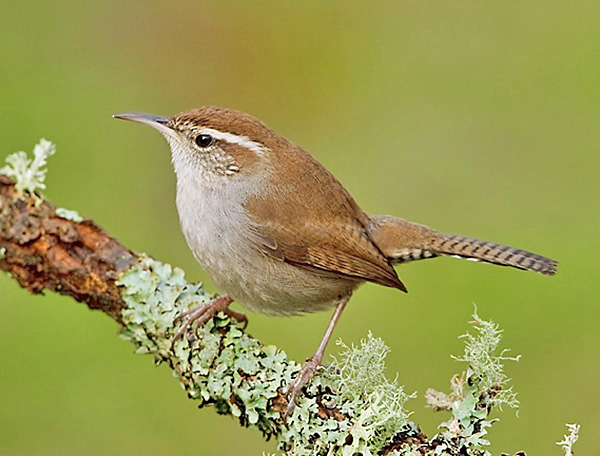
Photograph © Glenn Bartley
Bewick’s Wrens are typically non-migratory and prefer to live in open woodlands and dry and brushy environments along the Pacific Coast and in most of the Southwest in the United States.
They are rather modest in appearance with brown uppersides, grayish-white undersides, and a white “eyebrow” but have a distinctly long tail relative to their body size.
Bewick’s Wrens have black, slim, and long bills that are slightly downcurved. They use it to probe into bark crevices, glean insects from the foliage, or pick them from the ground.
After each meal, they wipe their bills clean against nearby plants. Adults occasionally puncture eggs in nearby nests.
Gnatcatchers – Family Sylviidae
A lot of these species are insectivorous. They generally have a thin and pointed bill they use to glean small invertebrates from foliage and bark crevices.
Blue-gray gnatcatcher
Polioptila caerulea
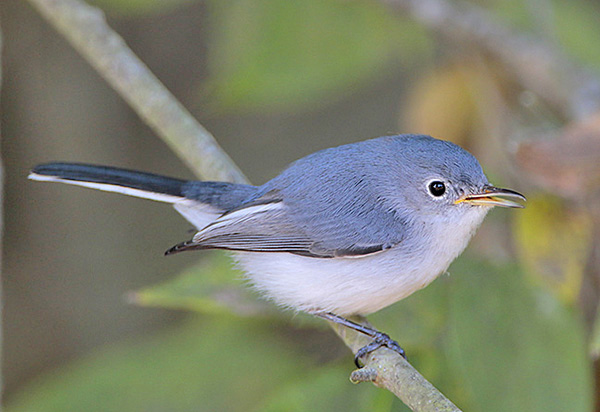
Photograph © Greg Lavaty.
Blue-gray Gnatcatchers are seen in North America, mainly during the breeding season. You can meet them in open deciduous woodlands and shrublands across the eastern and southern regions of the United States. They are fairly recognizable with their slim shape, long tails, pale blue-gray uppersides, and grayish-white underparts.
While females and nonbreeding males exhibit duller and darker colors, both genders share a straight, thin black bill.
The Blue-gray Gnatcatcher is known for its lively and active behavior, rarely pausing in its movements. It flutters energetically among shrubs and trees, with its tail held at a jaunty angle, as it chases after and snatches up small insects.
When faced with larger prey, the Blue-gray Gnatcatcher will beat them against a branch before consuming them.
Hummingbirds – Family Trochilidae
Often very small and iridescent, these species have a long, narrow bill that can be anywhere from straight to highly curved. The bird with the longest bill relative to their body size belongs to this family, which is the Sword-billed Hummingbird!
Rufous Hummingbird
Selasphorus rufus
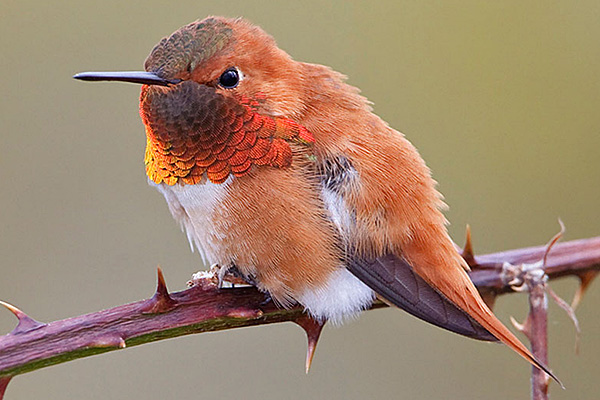
Male. Photograph © Glenn Bartley.
The Rufous Hummingbird is a near-threatened species found throughout western North America. During the breeding season, they can be found in open areas, parks, yards, and forests as far north as southernmost Alaska. Their wintering range reaches Mexico, where they mostly inhabit shrubby openings and oak-pine forests at middle to high elevations.
In favorable lighting, males of this species are striking, glowing like embers. They radiate with bright orange plumage on their back and belly, complemented by a vibrant iridescent-red throat. In contrast, females display a more modest appearance. They are primarily green above with rufous flanks and patches in their green tail, and often have a touch of orange on the throat.
This species has a slender, nearly straight bill that they use to extract nectar and capture tiny insects.
They’re also highly territorial and defend their territory throughout the year, attacking even larger creatures.
Broad-billed Hummingbird
Cynanthus latirostris
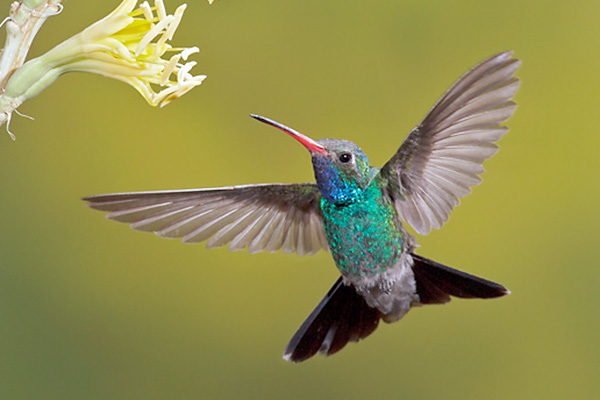
Photograph © Glenn Bartley.
The Broad-billed Hummingbird is small even when compared to other hummingbirds. They’re primarily found in canyons, streambeds, and foothills of Mexico, with their range extending into the southwestern United States.
Adult males of this species display a vibrant green plumage, highlighted by a shimmering blue throat. On the other hand, females have a golden-green upper body, gray underparts, and a white line behind the eye. They have a long, straight bill that is dark in females and red with a black tip in males.
When feeding on nectar, the broad-billed hummingbird hovers in mid-air, extending its bill and long tongue deep into the flowers. Male hummingbirds are known for defending their feeding territories and breeding sites, while females defend their nesting sites. The defense may include clawing and even using their bill as a weapon.
Rivoli’s Hummingbird
Eugenes fulgens

© Doug Donaldson
Rivoli’s Hummingbird, previously known as the Magnificent Hummingbird, is mostly found in Central America, with its range extending into the southwestern United States.
During the breeding season, it can be found in mountain canyons that have a stream or creek in the vicinity. In the Southwest, you can often see it in pine-oak forests in mountainous areas where there’s an abundance of flowers.
Their appearance truly earned them their previous name – males are blackish below and green above. In good lighting, you can see a striking purple crown and emerald throat. Females are less flashy. They’re predominantly gray below and greenish above. Both sexes have a small white mark behind their eyes.
Like other hummingbirds, they use their bills to extract nectar from flowers or catch small insects. When it comes to feeding nestlings, then females stick their bills down into their throats to regurgitate a mix of insects and nectar.
